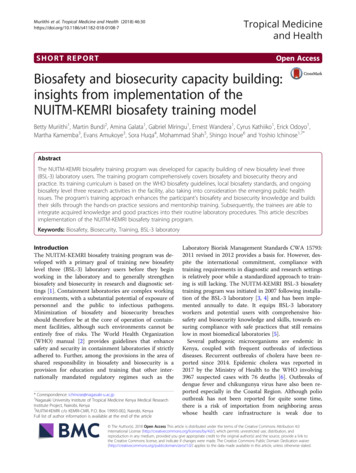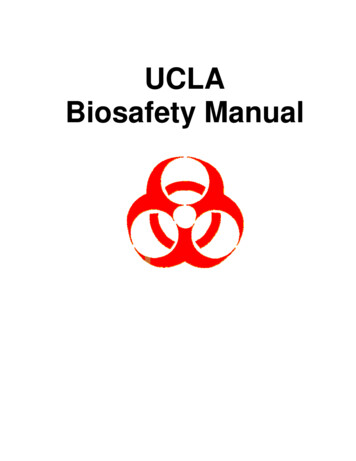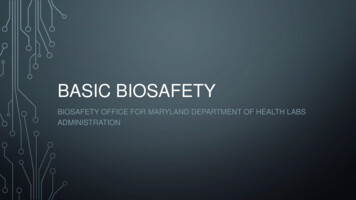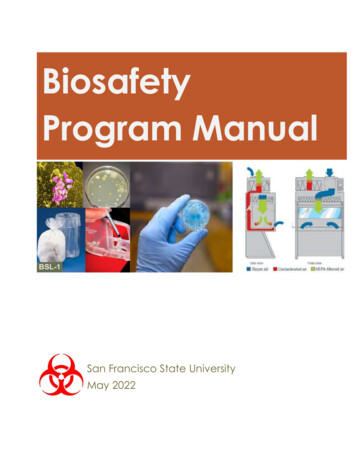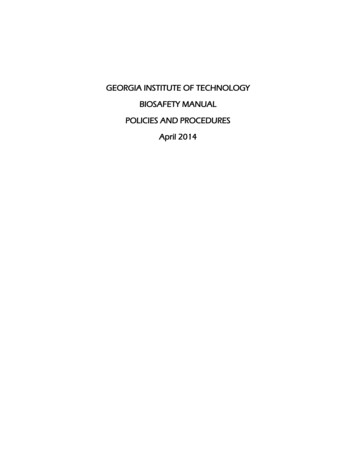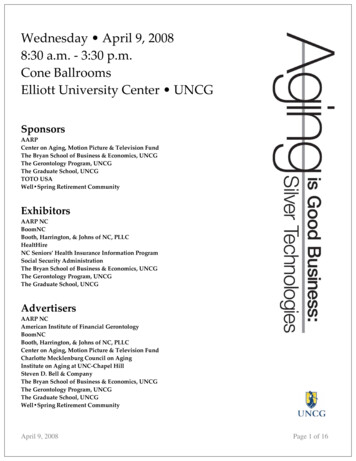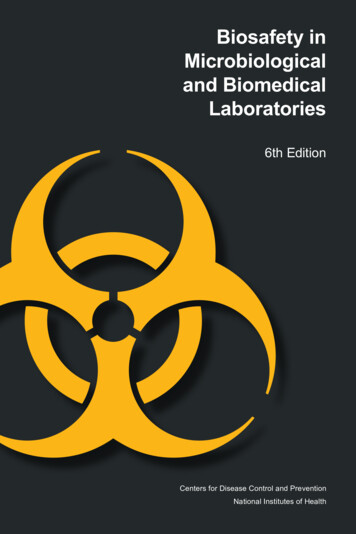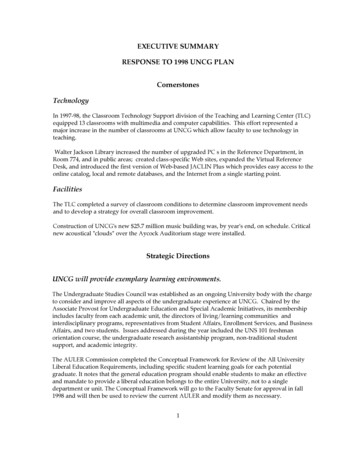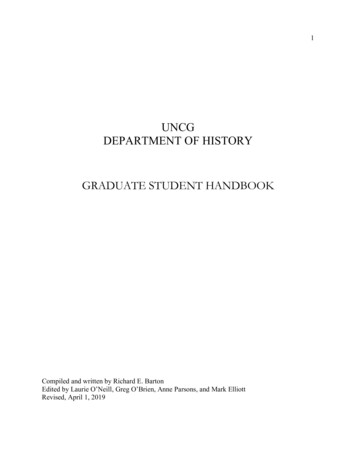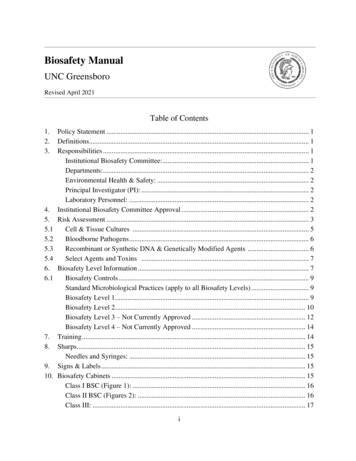
Transcription
Biosafety ManualUNC GreensboroRevised April 2021Table of Contents1.2.3.4.5.5.15.25.35.46.6.17.8.9.10.Policy Statement . 1Definitions. 1Responsibilities . 1Institutional Biosafety Committee:. 1Departments:. 2Environmental Health & Safety: . 2Principal Investigator (PI): . 2Laboratory Personnel: . 2Institutional Biosafety Committee Approval . 2Risk Assessment . 3Cell & Tissue Cultures . 5Bloodborne Pathogens . 6Recombinant or Synthetic DNA & Genetically Modified Agents . 6Select Agents and Toxins . 7Biosafety Level Information . 7Biosafety Controls . 9Standard Microbiological Practices (apply to all Biosafety Levels) . 9Biosafety Level 1 . 9Biosafety Level 2 . 10Biosafety Level 3 – Not Currently Approved . 12Biosafety Level 4 – Not Currently Approved . 14Training . 14Sharps . 15Needles and Syringes: . 15Signs & Labels . 15Biosafety Cabinets . 15Class I BSC (Figure 1): . 16Class II BSC (Figures 2): . 16Class III: . 17i
11. Transport and Shipping . 2011.1 Export Control Regulations . 20Permits . 2011.2 Packaging . 21Genetically Modified Microorganisms. 22Human Blood and Tissue . 22On-campus Transport Between Laboratories or Buildings . 2212. Waste. 2312.1 Autoclave Waste Decontamination . 24Parameters . 24Solid waste. 25Liquid waste . 25Training . 25Autoclave Precautions . 25Treatment of Liquid Biohazard Waste . 26Procedures for Inactivation and Safe Containment of Toxins. 30Treatment Off-Site. 3013. Spill / Release . 30Biohazard Spill Clean-Up Protocol . 30Biohazard Spill Kit . 3214. Biosecurity . 33Appendices . 34A.Weekly Autoclave Validation Log . 35B.Bloodborne Pathogens Exposure Control Plan Enrollment Form . 36ii
1.Policy StatementThe use of biohazardous materials shall comply with the NIH Guidelines, the recommendationsin the CDC publication Biosafety in Microbiological and Biomedical Laboratories (BMBL), andthe American Biological Safety Association (ABSA) best practices, as well as all federal, state,and local regulations.2.DefinitionsBiohazards - Infectious agents or hazardous biological materials that present a risk or potentialrisk to the health of humans, animals, or the environment. The risk can be direct throughinfection or indirect through damage to the environment. Any organism or virus listed inCDC/NIH Risk Group (RG) two, three, or four, or that requires Biosafety Level (BL) two, threeor four containment, is considered biohazardous.Biohazardous Materials - Include certain types of recombinant DNA (e.g. that expresspotentially infectious entities or potent toxins), or organisms and viruses infectious to humans,animals or plants (e.g. parasites, viruses, bacteria, fungi, prions, rickettsia); and agents ofbiological origin (e.g. toxins, allergens, venoms) that may cause disease in other livingorganisms or cause significant impact to the environment or community.Biological Materials - Any materials containing genetic information and capable of reproducingitself or being reproduced in a biological system.3.ResponsibilitiesThe responsibility for ensuring that work with biological materials is conducted safely extendsfrom the administration to the end user, as outlined below.Institutional Biosafety Committee: Establish guidelines, procedures, and application forms for the registration, use, andcontainment of rDNA and BSL-2 agents and/or procedures; Review, approve, and oversee rDNA research conducted at or sponsored by the Universityin accordance with the NIH Guidelines, regardless of the source of funding; Review of any experiments that introduce or expose biohazardous agents to plants,animals, or human participants; Assemble and approve the University’s Biosafety Policy Manual which contains biosafetystandards from the National institutes of Health (NIH), Centers for Disease Control andPrevention (CDC), and other applicable regulations.1Policy Statement
Departments: Provide laboratory facilities suitable for work being conducted;Environmental Health & Safety: Develop and maintain the Laboratory Biosafety Manual; Conduct semiannual safety and compliance review of laboratories; Assist Principal Investigator with risk assessment; Assist Principal Investigator with biohazard incident response (in case of major spill orenvironmental release).Principal Investigator (PI): Assess risks Submit protocols for IBC approval for work with rDNA and other non-exempt materials; Identify all biological hazards (BSL 1, rDNA, etc.) in Laboratory Safety Plan; Provide laboratory specific training to all personnel; Provide or arrange bloodborne pathogens (BBP) training and vaccinations if researchactivity includes human blood, unfixed tissues/cells, or other potentially infectiousmaterials; Proper disposal of biological waste; Report incidents (spills, exposures, etc.) to EH&S (336-334-4357); Other responsibilities as listed in the policy on biohazardous agents and rDNA.Laboratory Personnel: Conduct all procedures in accordance with the Laboratory Biosafety Manual and all otherapplicable university policies and procedures; Report incidents or safety concerns to principal investigator or EH&S.4.Institutional Biosafety Committee ApprovalTo ensure that UNCG operates its laboratories in compliance with all applicable biosafetyregulations and good laboratory practices, all researchers and lab directors who plan to userDNA must have a protocol approved by the Institutional Biosafety Committee (IBC) before thework can be initiated. Guidelines for the preparation of this protocol will be established by theIBC and can be found, in the IBC section of the Office of Research Integrity website.Researchers or lab directors who plan to use rDNA are responsible for knowledge of theUniversity’s procedures.Some rDNA projects and all BSL1 agents are exempt from IBC review. Work with BSL-2/RG2materials may be reviewed by the IBC on a case-by-case basis. Currently, BSL-3 and BSL-42Institutional Biosafety Committee Approval
agents are not approved for use at UNCG. Furthermore, the procurement and use of any agentdesignated by the Federal Government as a Select Agent is currently prohibited at UNCG. AnyUNCG investigator desiring to initiate work with BSL-3 or Select Agents must discuss this withthe Associate Provost for Research and Public / Private Sector Partnerships. Registration ofSelect Agents with the Federal Government must be done through the University’s ResponsibleOfficial (Vice Chancellor for Research and Economic Development) or their designee.5.Risk AssessmentThe biological risk assessment process is used to identify the hazardous characteristics of aninfectious or potentially infectious agent or material, if known; the activities that can result in aperson’s exposure to an agent; the likelihood that such exposure will cause a LaboratoryAssociated Infection (LAI); and the probable consequences of such an infection. The informationidentified by risk assessment will provide a guide for the selection of appropriate mitigations,including the application of Biosafety Levels, which outline the appropriate safety equipment,facility safeguards, and personal protective equipment and practices that can help prevent LAIs.The initial factors to consider in risk assessment fall into two broad categories: agent hazards andlaboratory procedure hazards. Following the assessment of the inherent risk, the Biosafety Leveland any additional indicated mitigation strategies are determined. Then, the proficiency of staffregarding safe practices and the integrity of safety equipment is evaluated and training orcompetency gaps are addressed.First, identify hazardous characteristics of the agent and perform an assessment of the inherentrisk, which is the risk in the absence of mitigating factors. Biological materials are classifiedinto Risk Groups 1 – 4, based on their principal hazardous characteristics of the agent, whichinclude infectivity or capability to infect and cause disease in a susceptible host, severity ofdisease; and the availability of preventive measures and effective treatments. Risk Group 1 represents the lowest risk materials which do not generally cause disease inhealthy adult humans. Risk Group 2 materials are associated with disease, but effective preventive or treatmentmeasures are available Risk Group 3 materials are known to cause serious and even lethal disease, wherepreventive or treatment measures MAY be available. Risk Group 4 agents are associated with lethal disease with little availability of knownpreventive or treatment methods.Several excellent resources provide information and guidance for making an initial riskassessment. Section VIII of BMBL provides agent summary statements for many agents,available here. Pathogen Data Safety Sheets generated by the Public Health Agency of Canada(PHAC) are available here. Appendix B of the NIH Guidelines for Research InvolvingRecombinant or Synthetic Nucleic Acid Molecules (NIH Guidelines) includes a list of etiologicagents, classified by Risk Group. ABSA International also has a compendium of organisms andRisk Group assignments from several countries and organizations available here.3Risk Assessment
A thorough examination of the agent hazards is necessary when the intended use of an agentdoes not correspond with the general conditions described in the agent summary statement orwhen an agent summary statement is not available. In addition, it is always helpful to seekguidance from colleagues with experience in handling the agent and from biological safetyprofessionals.Be well-characterized in regard to low risk. Once the inherent risk associated with the agent isconsidered, the next step in the process involves addressing the possibility of transmission of theagent. The most likely routes of transmission in the laboratory are: Direct skin, eye or mucosal membrane exposure to an agent; Parenteral inoculation by a syringe needle or other contaminated sharp, or by bites frominfected animals and arthropod vectors; Ingestion of liquid suspension of an infectious agent, or by contaminated hand to mouthexposure; and Inhalation of infectious aerosols.It is important to remember that the nature and severity of disease caused by a Laboratory-associated infection and the probable route of transmission of the infectious agent in the laboratorymay differ from the route of transmission and severity associated with the naturally-acquireddisease.An agent capable of transmitting disease through respiratory exposure to infectious aerosols is aserious laboratory hazard, both for the person handling the agent and for other laboratoryoccupants. Infective dose and agent stability are particularly important in establishing the risk ofairborne transmission of disease.When work involves the use of laboratory animals, the hazardous characteristics of zoonoticagents require careful consideration when completing a risk assessment. Evidence thatexperimental animals can shed zoonotic agents and other infectious agents under study in saliva,urine, or feces is an important indicator of hazard.The origin of the agent is also important when conducting a risk assessment. Non-indigenousagents are of special concern because of their potential to transmit or spread infectious diseasesfrom foreign countries into the United States. Importation of agents of human disease requires apermit from the CDC. Importation of many agents of livestock, poultry, and other animaldiseases requires a permit from the USDA’s Animal and Plant Health Inspection Service(APHIS).Second, identify laboratory procedure hazards. The principal laboratory procedure hazards areagent concentration, suspension volume, equipment and procedures that generate small particleaerosols and larger airborne particles (droplets), and use of sharps. Procedures involving animalscan present a number of hazards such as bites and scratches, and exposure to zoonotic agents.Aerosols and droplets Aerosols are a serious hazard because they are ubiquitous in laboratoryprocedures, are usually undetected, and are extremely pervasive, placing the laboratory workercarrying out the procedure and other persons in the laboratory at risk of exposure.4Risk Assessment
Procedures that impart energy to a microbial suspension will produce aerosols. Equipment usedfor handling and analyzing infectious agents in laboratories, such as pipettes, blenders,centrifuges, sonicators, vortex mixers, cell sorters, and matrix-assisted laserdesorption/ionization-time of flight (MALDI-TOF) mass spectrometers are potential sources ofaerosols. These procedures and equipment generate respirable-size particles that remain airbornefor protracted periods. These particles can remain in the lungs if inhaled or create an exposurehazard for coworkers in the laboratory or persons occupying adjacent spaces open to airflowfrom the laboratory.Procedures and equipment that generate respirable size particles also generate larger size dropletsthat settle out of the air rapidly, contaminating hands, work surfaces, and possibly the mucousmembranes of the persons performing the procedure.Personal Protective Equipment (PPE) and Safety Equipment Hazards There may be hazardsthat require specialized PPE in addition to safety glasses, laboratory gowns, and gloves. Forexample, a procedure that presents a splash hazard may require the use of a mask and a faceshield to provide adequate protection.Third, make a determination of the appropriate Biosafety Level and select additional precautionsindicated by the risk assessment. See Section 6 for information on Biosafety Levels. Mostbiological materials handled on campus are well understood and have been assigned a minimumappropriate Biosafety Level, published by the supplier or one of the other resources referencedpreviously in this section. There will be situations where the intended use of an agent requiresgreater precautions than those described in the agent’s summary statement. These situations willrequire the careful selection of additional precautions.Fourth, as part of an ongoing process, evaluate the proficiencies of staff regarding safe practicesand the integrity of safety equipment. The protection of laboratory workers, other personsassociated with the laboratory, and the public will depend ultimately on the laboratory workersthemselves. The laboratory director or principal investigator shall ensure that laboratory workershave acquired the technical proficiency in the use of microbiological practices and safetyequipment required for the safe handling of the agent and have developed good habits thatsustain excellence in the performance of those practices.5.1Cell & Tissue CulturesWorkers who handle or manipulate human or animal cells and tissues are at risk for possibleexposure to potentially infectious latent and adventitious agents that may be present in those cellsand tissues, such as latent herpes virus, human immunodeficiency virus (HIV), hepatitis B virus(HBV), and hepatitis C virus (HCV). It is prudent to consider all cell lines to be potentiallyinfectious. Most cell and tissue cultures can be safely manipulated using BSL-2 practices andcontainment. All primary and permanent human or other primate cell lines or tissue cultures shall behandled using BSL-2 practices and containment. Personnel handling human cell and tissue cultures are deemed to be occupationallyexposed to bloodborne pathogens and shall follow the UNCG Bloodborne PathogenExposure Control Plan.5Risk Assessment
If any cell or tissue cultures are known or suspected to contain a specific pathogen oroncogenic virus, appropriate biosafety practices for handling that virus shall be used whenworking with the cell or tissue culture. BSL-1 practices and containment may be used for cell lines that meet all of the followingcriteria. Cells shall:oo5.2Not be of human or other primate origin.Be confirmed not to contain human or other primate pathogens, including viruses,pathogenic bacteria, mycoplasma, or fungi, classified as Risk Group 2 or greater.Bloodborne PathogensThe Occupational Safety and Health Administration (OSHA) Bloodborne Pathogens Standard(BBP, 29 CFR 1020.1030) requires specific training and inoculation for individuals with anoccupational exposure to bloodborne pathogens. Bloodborne pathogens are disease-causingmicrobes present in blood, unfixed tissue, and other potentially infectious material. Pathogensinclude, but are not limited to Human Immunodeficiency Virus (HIV) and Hepatitis B and C(HBV, HBC), other infectious viruses, bacteria and protozoa. Occupational exposure isreasonably anticipated skin, eye, mucous membrane, or parenteral (subcutaneous) contact withblood or other potentially infectious materials that may result from the performance of anemployee’s duties.Laboratory workers with an occupational exposure must complete Laboratory Biosafety Trainingwithin 10 days of their work assignment or commencement of activities presenting anoccupational exposure, and annually thereafter. Once initial training is completed, workers mustcomplete and submit the Bloodborne Pathogens Exposure Control Plan Enrollment Form andcomplete or decline the HBV vaccine series, at no cost to them. The vaccination is not requiredif the individual has completed the vaccine series previously or tests positive, but the declinationform must be completed. Gove Student Health Center administers the vaccine to students andemployees as a series of three injections, the second and third administered one and six monthsafter the first.The principal investigator or laboratory director is responsible for identifying workers with anoccupational exposure and ensuring that required training and vaccinations (or declinations) arecompleted. The laboratory department is responsible for the cost of the HBV vaccination.5.3Recombinant or Synthetic DNA & Genetically Modified AgentsAll work with recombinant or synthetic DNA or genetically modified agents must be registeredwith the Institutional Biosafety Committee and comply with the NIH Guidelines for ResearchInvolving Recombinant or Synthetic Nucleic Acid Molecules.The identification and assessment of hazardous characteristics of genetically modified agentsinvolve consideration of the same factors used in risk assessment of the wild-type organism. It isparticularly important to address the possibility that the genetic modification could increase ordecrease an agent’s pathogenicity or affect its susceptibility to antibiotics or other effectivetreatments. The risk assessment can be difficult or incomplete because important information6Risk Assessment
may not be available for a newly engineered agent. The NIH Guidelines are the key reference inassessing risk and establishing an appropriate Biosafety Level for work involving recombinantDNA molecules.5.4Select Agents and ToxinsCertain biological agents or toxins which may pose a severe threat to human, animal, or planthealth and safety are classified as Select Agents and require federal registration and approval. Alist of Select Agents and Toxins can be found here. The US Department of Health and HumanServices (DHHS) regulates the possession, use, and transfer of agents or toxins that could pose asevere threat to public health and safety. The US Department of Agriculture (USDA) regulatesthe possession, use, and transfer of agents or toxins that could pose a severe threat to animal orplant health, or animal or plant products. As such, entities must register with CDC or APHIS ifthey possess, use, or transfer select agents or toxins.The procurement and use of any agent designated by the Federal Government as a Select Agentis currently prohibited at UNCG. Any UNCG investigator desiring to initiate work with BSL3 orSelect Agents must contact the Vice Chancellor for Research and Economic Development.Registration of Select Agents with the Federal Government must be done through theuniversity’s Responsible Official (Vice Chancellor for Research and Economic Development) ortheir designee.6.Biosafety Level InformationFour Biosafety Levels are described in this section, which outline the appropriate laboratoryfacilities and practices for work with biological agents or material which may carry them.Biological agents are assigned BSL’s based on the risk they pose to human health and theenvironment. The likelihood to cause disease, severity of disease, and routes of transmission areconsidered when determining the appropriate BSL. All biological agents or materials used in thelaboratory shall be listed on the Biological Material ID Form in the Laboratory Safety Plan.Biosafety Level 1 is the basic level of protection and is appropriate for agents that are not knownto cause disease in normal, healthy humans. Examples of BSL-1 materials are non-pathogenicstrains of bacteria and fungi.Biosafety Level 2 is appropriate for handling materials potentially containing moderate-riskagents that cause human disease of varying severity by ingestion or through percutaneous ormucous membrane exposure. BSL-2 is appropriate when work is done with Any infectious pathogenic microorganisms. Any human primary cells or cell lines. Other Potentially Infectious Materials (OPIM), defined as any human-derived blood, bodyfluids, or tissues, where the presence of an infectious agent may be unknown. Cells or other materials from animals known to have been infected with human pathogens.7Biosafety Level Information
Biosafety Level 3 is appropriate for agents of indigenous or exotic origin with a known potentialfor aerosol transmission and for agents that may cause serious and potentially lethal infections.Research with BSL-3 agents is CURRENTLY NOT APPROVED AT UNCG.Biosafety Level 4 is appropriate for agents that pose a high individual risk of life-threateningdisease by infectious aerosols and for which no treatment is available. Research with BSL-4agents is CURRENTLY NOT APPROVED AT UNCG.Microorganisms listed by Biosafety Level can be found here, and a list of organisms and toxinsclassified as “Select Agents” (having the potential to pose a severe threat to public, animal orplant health or to animal or plant products) can be found here.BSL AgentsPracticesSafety Equipment(Primary Barriers)Facilities(Secondary Barriers)1Not known toconsistently causedisease in healthyadultsStandard microbiologicalpracticesPPE: Lab coats and glovesrecommended; eye andface protection as neededNon-porous surfaces (benchtops, floors, chairs)Sink for hand washingDoors for access controlWindows that open shouldhave screens2Associated withhuman disease.Routes oftransmission:percutaneous,ingestion, mucousmembraneBSL-1 practice plus:Limited accessBiohazard warning signsSharps precautionsWritten procedures forwaste decontaminationor medical surveillancePrimary barriers: Class I orII BSC for manipulationsthat may cause splashes oraerosols, vacuum linesprotected with liquiddisinfectant traps;PPE: Lab coat and glovesrequired; Face and eyeprotection as neededBSL-1 plus:Eyewash readily availableAutoclave availableWindows that open are fittedwith screensDoors should be self-closing3Indigenous orexotic agents withpotential foraerosoltransmission;disease may haveserious or lethalconsequencesBSL-2 plus:Controlled accessDecontamination of allwasteDecontamination of labclothing beforelaunderingBaseline serumPrimary barriers: Class I orII BSC or other physicalcontainment device usedfor all open manipulationsof agents, vacuum linesprotected with disinfectanttrap and HEPA filter;PPE: Lab coat and glovesrequired; face, eye, andrespiratory protection asneededBSL-2 plus:Physical separation fromaccess corridorsSelf-closing double-dooraccessExhaust air not recirculatedNegative airflow intolaboratoryTable 1. Summary of defining characteristics and lab requirements for BSL 1-4.8Biosafety Level Information
6.1Biosafety ControlsAll researchers using potential biohazards shall, at a minimum, follow the StandardMicrobiological Practices as listed below.Standard Microbiological Practices (apply to all Biosafety Levels) Laboratory supervisor (PI) shall enforce all institutional policies and procedures thatcontrol access to the laboratory. Persons shall wash their hands after working with potentially hazardous materials andbefore leaving the laboratory. Eating, drinking, smoking, handling contact lenses, applying cosmetics, and storing foodfor human consumption shall not be permitted in laboratory areas. Food shall be storedoutside the laboratory area in cabinets or refrigerators designated and used for thispurpose. Mouth pipetting is prohibited. Long hair is restrained so that it cannot contact hands, specimens, containers, orequipment. All procedures shall be performed to minimize the creation of splashes and / or aerosols. All work surfaces shall be decontaminated after completion of work and after any spill orsplash of
1 Policy Statement 1. Policy Statement The use of biohazardous materials shall comply with the NIH Guidelines, the recommendations in the CDC publication Biosafety in Microbiological and Biomedical Laboratories (BMBL), and the American Biological Safety Association (ABSA) best practices, as well as all federal, state,
